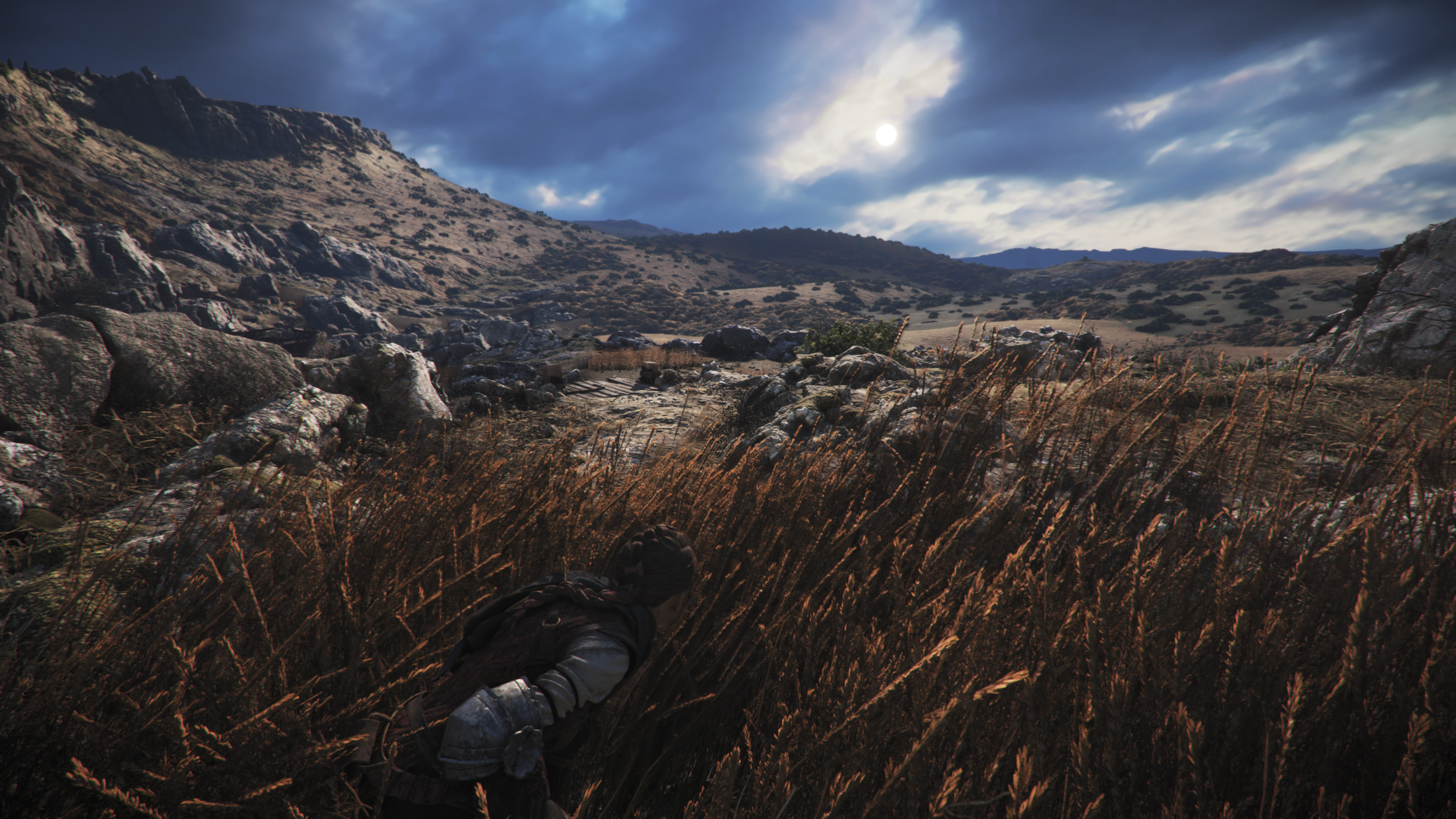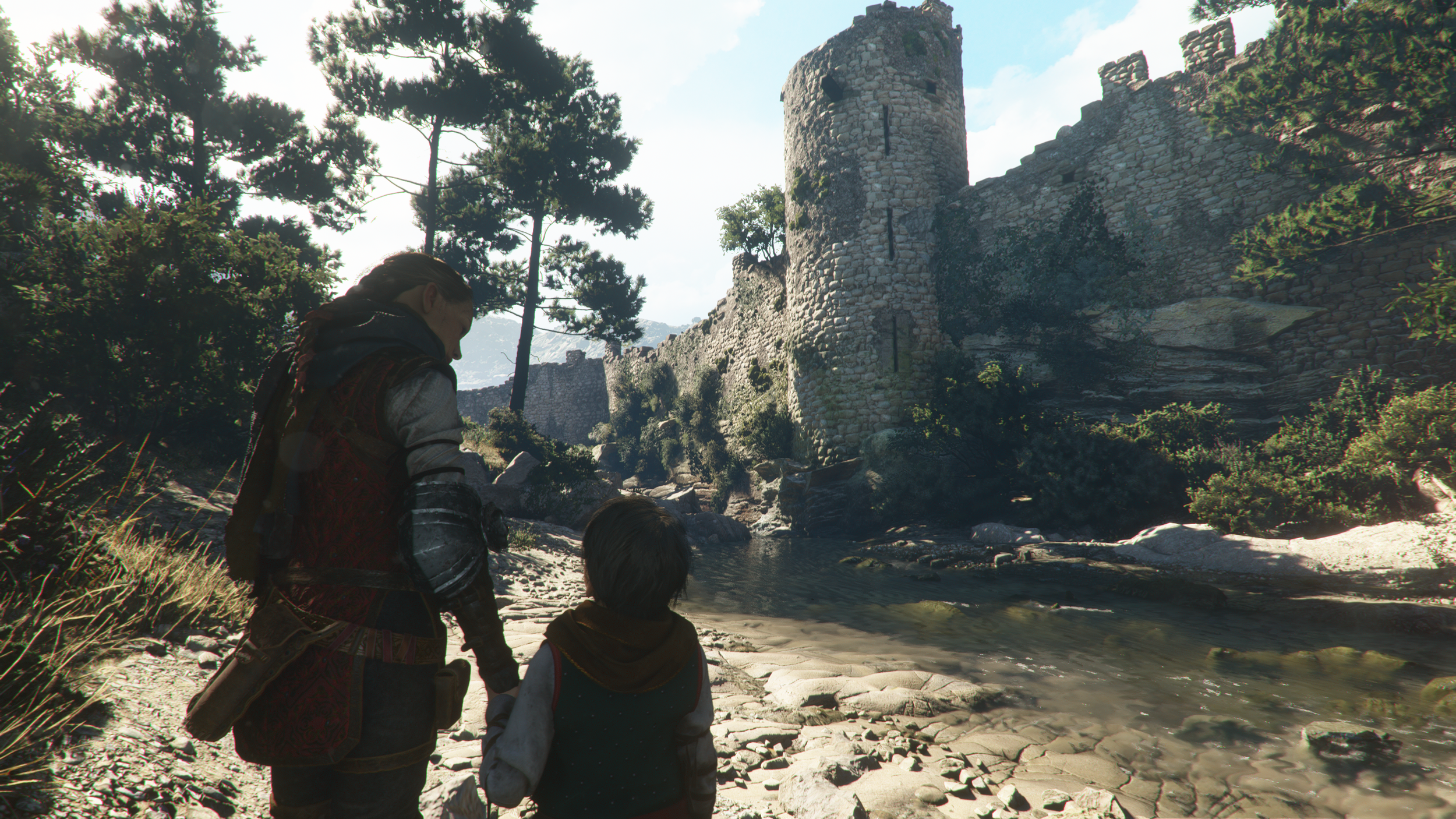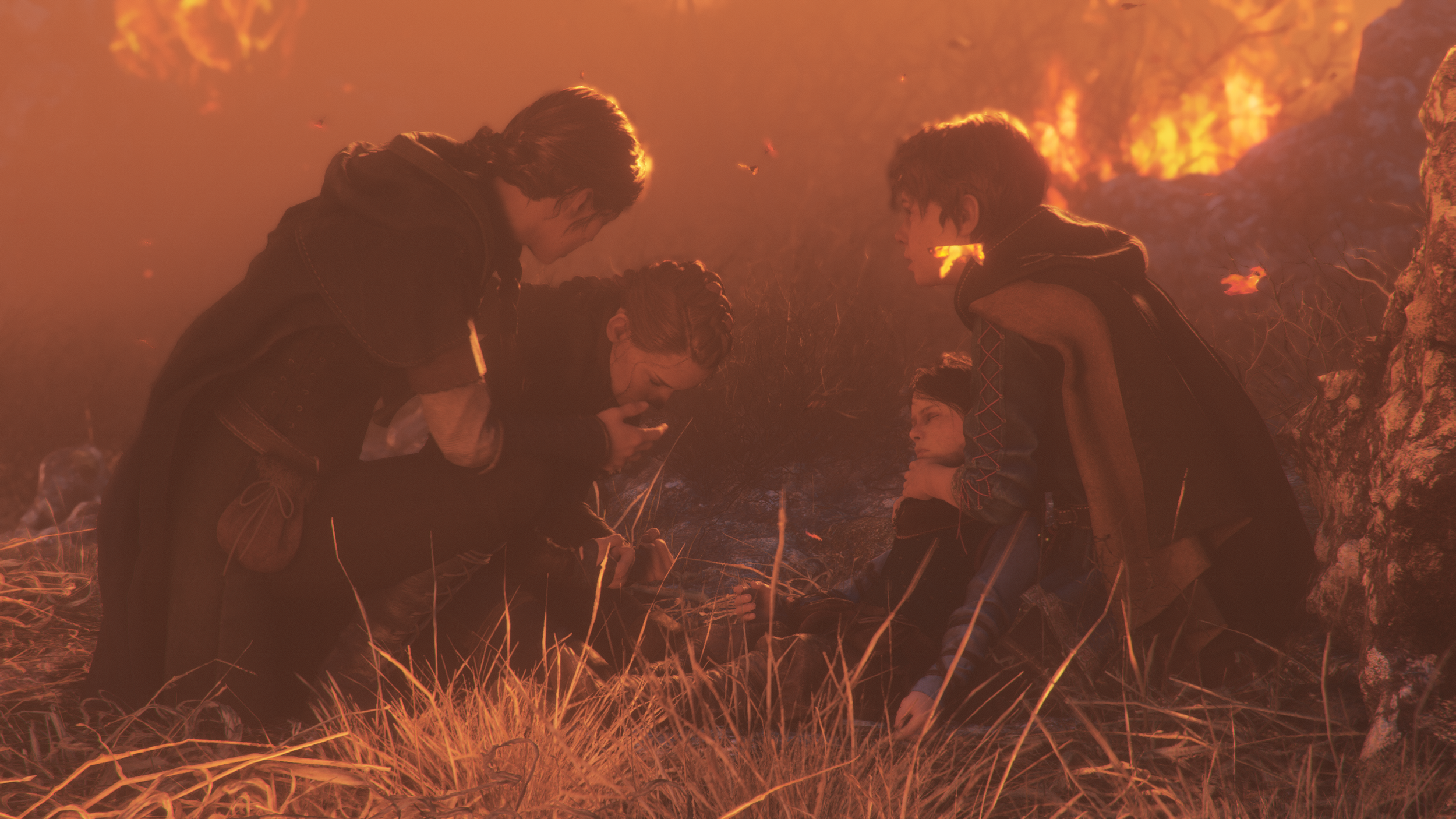The first time I played a Plague Tale Innocence I didn't really know what to expect. It drew me in with its fascinating world-building and horrific rat hordes that eat people like kids eat pizza. I haven't had time to replay the first game but I do remember enjoying the pacing and being surprised at how much the experience changed towards its conclusion. The fact that you spend the majority of the game as a weak and frightened young girl makes the empowerment in the last few chapters all the more enjoyable. It was obvious that if we did get a sequel the characters would be more capable, especially Amicia who fought tooth and nail to keep her little brother alive. We now see Hugo and his doting sister continue their journey in an attempt to understand the condition he faces and ultimately drive it from his body.
Light and Dark
In the first few hours of the game, I was really struggling to like Amicia as a character. While I do think the overall story arc is excellent, Amicia seemed stuck in this constant loop of complaining and hysterical jabbering. I feel like maybe the writers have tried to replicate the internal dialogue we see in the wonderful Hellblade: Senua’s Sacrifice. In Requiem, however, it came across like a constant stream of peevish negativity and your first sidekick Lucas just seemed to make her worse. However, as the story in this second game unfolded, I did have to remind myself that this young woman has been through the mill and seen things that would drive most of us to the brink of sanity. As the credits rolled I would say my mind on Amicia had been changed somewhat, even if her obsession with finding answers often puts Hugo in even more danger.
In contrast her young brother, when not in danger, still has that youthful optimism where every hill is a fort to conquer and every new experience is the most exciting thing ever. As a parent with a young son, I did feel genuine empathy for him as he struggles to deal with his affliction while still trying to be a kid when he can. In some heart-wrenching scenes, we see places that seemed safe and even welcoming descend into tragic chaos: ultimately he knows he is the catalyst for this destruction. Who wouldn’t feel a deep well of guilt, even if a rational mind would know no blame is on him.
Ratatouille
So like the first game, a horde of flesh-eating rats hound your journey and act as one of the game's stand-out elements. In smaller numbers, these vicious rodents do look and move like a skittering swarm. However, very soon you will start to see their numbers reach many millions and it’s then they more resemble a gigantic rat tsunami. As the bigger hoards break over rock and wood like a biblical flood, very little can stand against their sheer weight of numbers. It is very impressive to behold and makes for some truly jaw-dropping sequences.
As in innocence, the one surefire way to repel these flesh-eating critters is light, giving us the meat and potatoes for the gameplay loop. Keeping in the light and making your own light are all part of the equation. As you might expect, the number of tools open to Amicia has increased along with a new understanding of Alchemy. Now you can make tar that slows enemies and burns them if ignited. Understanding what all these compounds do is half the story and then combining them with different tools makes for some very engaging gameplay.
As the conclusion of Innocence suggested, Hugo does have a connection with these rat hordes and can at times even take control of them. I was worried this would make the game too easy but thankfully this ability is limited in how much and where it can be used. Interestingly the connection to your rodent buddies can also give Hugo a visual insight as to where human enemies are. In most games, I tend to dislike these wall-hacking skills but here it makes sense and gives you a much-needed edge.












David and Goliath
While Amicia has a new taste for combat she is still relatively weak compared to the battle-hardened brutes ambling around. This combined with her being outnumbered means she must still use stealth and her environment in order to keep her party alive. Using buildings, tall grass and other objects you can stay out of sight. Enemies will spot you pretty fast out in the open and from a good distance away. You can distract them with various means and I have found the enemy AI to be very well implemented. For example, if you try to misdirect a soldier too many times they will realise someone is out there and the jig is up.
I do like how the game does give you a choice (most of the time) in how many guards you dispatch. The game is also watching how you play and your skill tree will develop accordingly. If you whisper past areas without the guards even knowing you were there, your sneaking skills will be enhanced with related improvements. In contrast, if you do a lot of direct combat you will gain abilities like the shove which lets you push foes into rats or fire. Your sling can kill a solider outright if he doesn't wear a helmet. If knocked down you do have the option to swipe them with your sling and attempt to get away. Getting behind the weaker troops gives you the option for a takedown. I love the animation for this as you can really see Amica almost falling over on the last strike as she throws everything her small frame can muster.
There are still options like setting grass on fire with a flaming pot or snuffing out their torch allowing the rats a quick meal. If you acquire a knife you can take out one guard instantly, however, these weapons are rare and can also be used to open resource-filled workbenches. If you do go full Solid Snake and start offing entire camps this will be commented on by my companions which I thought was a nice touch. Speaking of companions, you will have a selection that tag along at various points and can assist in different ways. Lucas, for example, can snuff out light sources but Arno can be asked to directly kill any enemy (at which he is very efficient). Using allies in puzzles is also something you must do in order to beat certain sections. While not too taxing these sections are well-designed and add another welcome layer to the fold.
Is it PC?
So Requiem is truly beautiful and would even give the latest Assassin's Creed games a run for their money. The team at Asobo Studios have taken the fairly claustrophobic areas in the first game and expanded them tenfold. Vast open fields, towering mountains and never-ending rivers are all here to enjoy. Even some of the darker underground settings have been designed using much more real estate. For the most part, this is a massive win because level design still gets Amicia into some fairly cramped locations whether that be squeezing between buildings or wading through rotting cesspools. At stages throughout the game, there are areas of respite when exploring small villages and towns. These sections, especially one around halfway through the game, are just lavished with attention to detail. People working on their stalls, making goods, dancing in the street and many more sights. The developers have even made kids look like actual kids, a feat that is notoriously difficult in gaming.
I reviewed Requiem on a very powerful rig sporting 32GB of Ram, an overclocked i9 12900K chip and 3080ti. So I was quite taken aback when I was only getting between 55-70 fps at 1440p. If I switched on DLSS to quality I was getting between 80-90 fps so this will definitely help those with lower-end systems. The situation on console, even PS5, is apparently worse with many asset-heavy scenes bringing the fps down to single figures and the game is hard-locked at 30 fps. This seems like an optimisation issue and I hope work is done post-launch to remedy it. At the time of writing, there is no RTX support in the game but this is being added soon. As much as I am a fan of RTX in games, I shudder to think how this will tank the fps in a game already creaking under the weight of its own beauty
As for the rest of the package, the game does have a few pathing bugs I have come across. Not being able to walk past the top of the stairs in one section was very frustrating but I managed to find an alternate path. I’ve also seen a handful of guards stuck on scenery which kinda kills the immersion. Other than that the game has been solid. The menu screen offers plenty of options both in controls and graphical tweaking. In terms of sound, it is great news across the board. All the voice actors do a fantastic job and really bring plenty of emotion onto the screen. Music has also been handled diligently with plenty of orchestral pieces that can elevate the mood or add dread at the right moments.
Conclusion
Asobo Studios obviously took some time to nail down what made the first game such a success. I am glad that while combat is more fleshed out, they still kept that sense of vulnerability intact. Of course, there are significantly more rats this time around, that was a given and it’s here we see the greatest departure to pure fantasy. I think most gamers will admire the spectacle that follows, but some might see these rat tsunamis as a step too far.
The mental health of Amicia also seems to be a bigger factor and as your situation goes from bad to worse; you can see the cracks starting to appear. By the conclusion of the game, I also felt mentally exhausted which was thanks to excellent pacing and some very harrowing scenes. Without spoilers, I will be interested to see if Asobo Studios are planning a third game, but I would be quite happy for the story to end here. So can I recommend Requiem? Well if you have the horsepower to run it at a decent framerate then absolutely yes. Everything comes together to make this a real contender for Game of the Year.
















